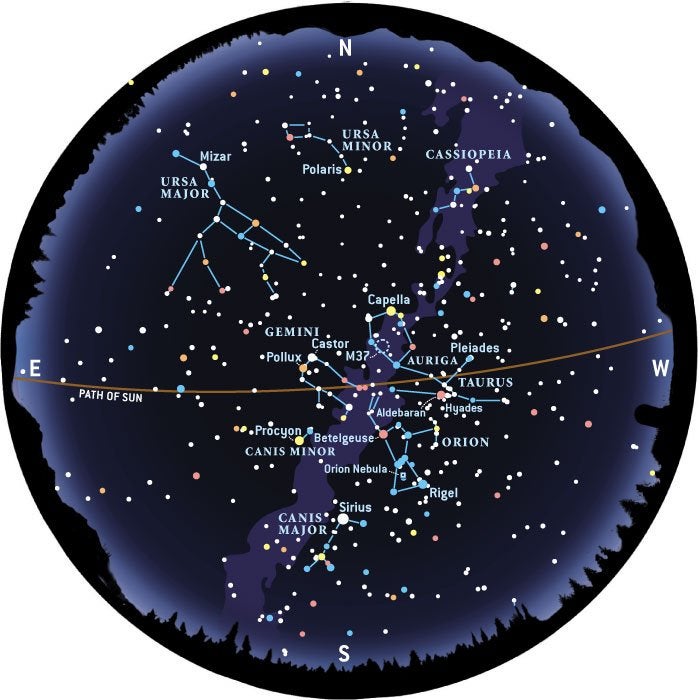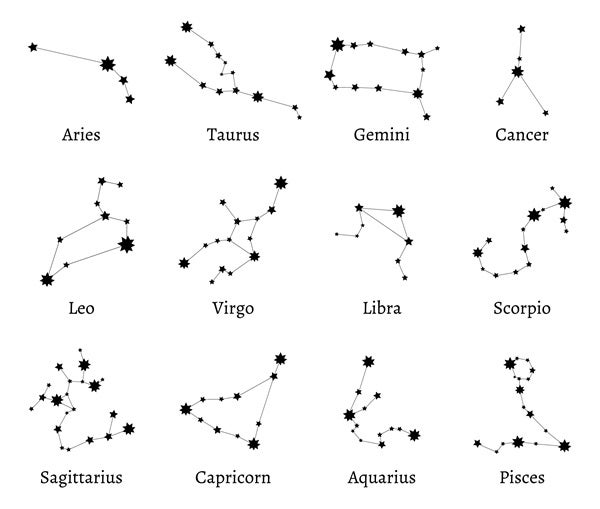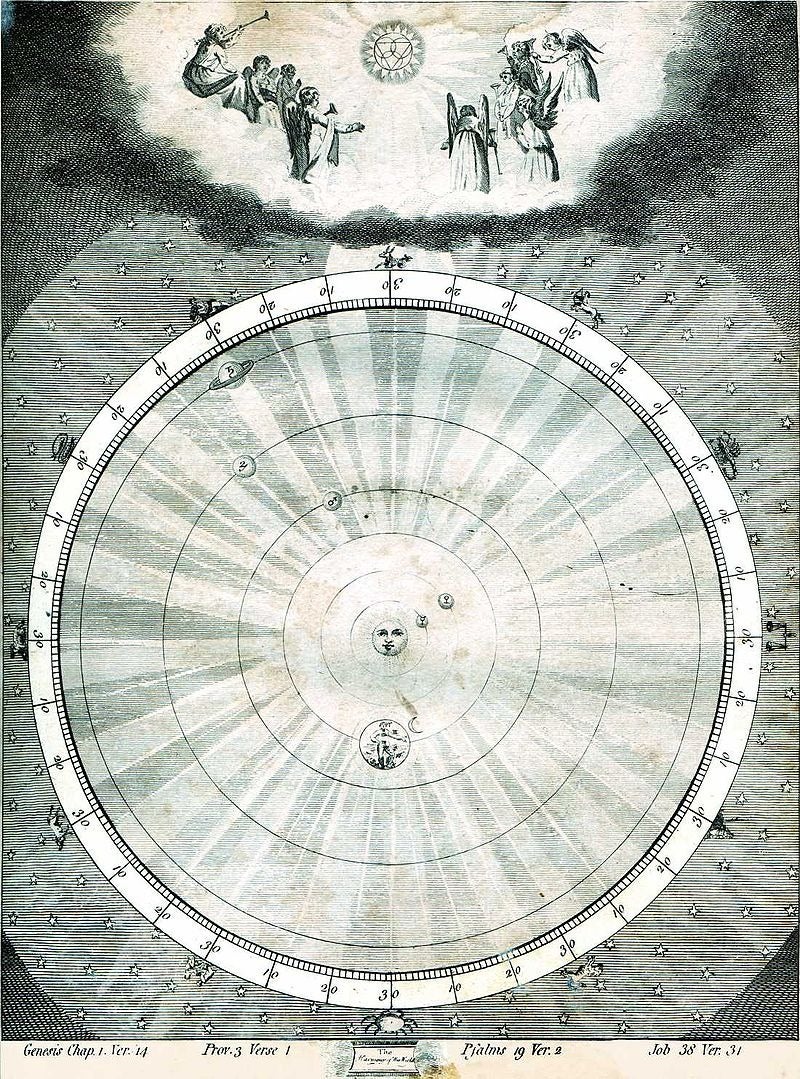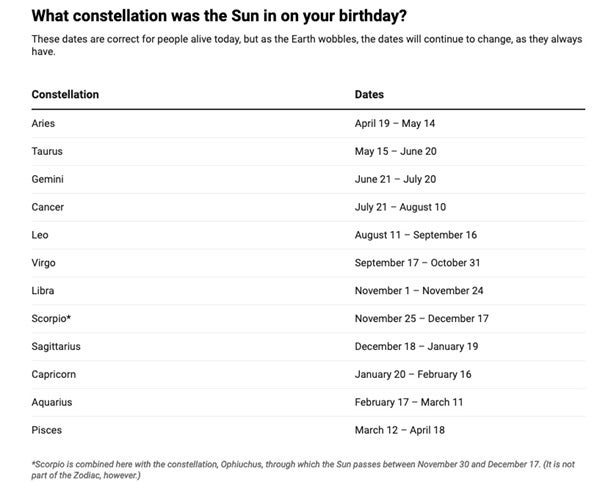
You are navigating a complex relationship at work. Patience will be your friend. Meanwhile, an unexpected financial opportunity awaits right around the corner. Your attention to detail will be well rewarded.
Sounds good, right? Even though I just made this up on the spot, it reads like a typical newspaper horoscope. These horoscopes are based on the signs of the zodiac, a loose collection of constellations that the Sun passes through every year. This itself is a form of astrology, which claims that heavenly objects, especially the positions of the Moon, Sun, and planets with respect to the constellations, can determine and even predict our lives. While astrology has been regarded as a pseudoscience for well over two hundred years, many people around the world continue to seek comfort in their signs, carrying on a human tradition that spans millennia.
The history of the Zodiac
With modern astronomy we now understand that the planets of the solar system orbit around the Sun in roughly the same plane. Since the Earth is just one of those planets sharing the same plane, from our perspective the Sun, the Moon, and all the other planets march around the sky following roughly the same path, a wide belt extending from horizon to horizon. This band is known as the zodiac.
We also know from modern astronomy that the constellations are figments of our imagination (with beautiful, meaningful stories attached to them, but still figments). Stars that appear to be associated with each other can be thousands of light-years apart, but projected on our sky they can resemble people, animals, or familiar objects.
And so it’s no surprise that ancient astronomers believed that there was a significant connection between the two. The paths of the Sun, Moon, and planets don’t cross in front of every constellation, and so in a cruel, random, and violent world, perhaps there was some important lesson to be learned by that coincidence.
Almost every culture on Earth has developed some form of astrology, which attempts to use the positions of heavenly objects to predict the fortunes of our lives. In Western traditions, the practice of astrology coalesced around an analysis of the zodiac and the constellations along that band. Beginning thousands of years ago in ancient Babylonia, astronomers divided the zodiac into equal-sized areas, each one corresponding to a constellation. That tradition made it to the Greeks, who passed it on to the Romans, who spread it throughout Europe.
The most popular expression of zodiac-based astrology is through these “signs” of the zodiac; specifically, the relationship of the Sun to those signs. When you ask someone what their sign is, you’re really asking where the Sun was located in the sky on the date of your birth, and which constellation of the zodiac it was closest to. Of course astrological systems can become much more complicated than that, but if you read a horoscope in the newspaper, that’s the fundamental idea.
The signs of the Zodiac

The zodiacal signs begin on March 21, the Spring equinox, and progress in roughly 30-day increments throughout the rest of the year. Each portion of the sky, corresponding to 30 degrees of distance along the band of the zodiac, has an associated constellation, name, and symbol:
- Aries, The Ram, symbolized by ♈️, 🐏, from March 21 to April 20
- Taurus, The Bull, symbolized by ♉️, 🐂, from April 21 to May 21
- Gemini, The Twins, symbolized by ♊️, from May 22 to June 21
- Cancer, The Crab, symbolized by ♋️, 🦀, June 22 to July 23
- Leo, The Lion, symbolized by ♌️, 🐆, from July 24 to Aug. 23
- Virgo, The Maiden, symbolized by ♍️ , from Aug. 24 to Sept. 23
- Libra, The Scales, symbolized by ♎️, ⚖️, from Sept. 24 to Oct. 23
- Scorpio, The Scorpion, symbolized by ♏️, 🦂, from Oct. 24 to Nov. 22
- Sagittarius, The Archer, symbolized by ♐️, 🏹, from Nov. 23 to Dec. 21
- Capricorn, The Goat, symbolized by ♑️, 🐐, from Dec. 22 to Jan. 20
- Aquarius, The Water-Bearer, symbolized by ♒️, 🏺, from Jan. 21 to Feb. 19
- Pisces, The Fish, symbolized by ♓️, 🐟, from Feb. 20 to March 20
The split between astronomy and astrology
For millennia astronomy and astrology were synonymous. The earliest astronomers weren’t just interested in cataloging the positions of the stars or mapping the movements of the planets. They were charged with creating accurate horoscopes and predicting the fates and fortunes or rulers and common people alike. In fact, many astronomers associated with the scientific revolution were in fact more interested in astrology than anything else.
For example, Johannes Kepler, who discovered that the planets move in ellipses rather than circles, believed that most horoscopes were utter trash…because the horoscopes he produced were so much better. He searched for divine geometry in the motions of the planets, hoping to find a way to predict Earthly affairs. He used the elliptical paths of the planets to inform his thinking. For example, he found that the ratio of the fastest to slowest speed of the Earth in its orbit was the same ratio as the musical notes fa and mi, which he decided were obvious, because Earth was where famine and misery hold sway.
What made Kepler’s approach so successful, and the heliocentric conception of the universe that it depended on, wasn’t some elegant mathematical proof or keen scientific insight. It was because with Kepler’s math the calculation of horoscopes became so much simpler and more accurate.

By the 1800’s, however, astrology began to separate from astronomy. By that time astronomers had discovered two new planets in the solar system, and began to realize that a) there were a lot more stars than we had previously thought and b) those stars were impossibly far away. Armed with a newfound understanding of the gravitational force, they realized that the planets and stars could have no influence whatsoever on our Earthly lives, and the profession of astronomy began to focus more on the physics of the cosmos rather than astrological predictions.
The missing pieces of the Zodiac
Once astronomy and astrology split, the science powering astronomical observations didn’t carry over into horoscope predictions. One of the examples of this is the existence of two new planets, Uranus and Neptune, that were unknown to ancient astronomers. If the astrological picture is true, and the planets directly influence our lives, then we have been getting our predictions wrong this whole time.
The other is in the precise alignment of heavenly objects. According to the list above, the date of your birth determines your sign. But those dates were decided in ancient times. The Earth slowly wobbles on its axis. This means that when astrological signs were first identified, the Spring equinox was in the constellation Aries. But nowadays it’s not; it’s in Pisces. That means your astrological “sign” is off by about a month – along with all the predictions that entails.
Lastly, the traditional signs of the zodiac don’t perfectly fit the path of the Sun. The constellations have all sorts of sizes, shapes, and arrangements on the sky. For astrological purposes each one takes up a neat 30 degrees of length along the sky, but some are smaller and some are bigger, and they don’t all exactly line up with the path of the Sun. Indeed, there’s one constellation, Ophiuchus, that definitely falls along the band of the zodiac but it not included in almost all astrological systems.

Astrology is not science
Today astrology is widely considered a pseudoscience. That makes it a “false” science. It gives the appearance of science – namely, offering predictive power based on the motions of physical objects. But it fails several basic scientific tests. For example, the predictive power of horoscopes has been tested time and again and come up short. In one famous experimental setup, participants are given a horoscope “tuned” to their astrological sign, then asked to rate how relevant their horoscope is to their personal lives. Participants typically give high ratings to horoscopes, usually around 8/10. But then the experimenter reveals the trick: everyone received the exact same horoscope, regardless of their birthdate.
(Below: The Forer Fallacy of Personal Validation experiment)
Horoscopes are typically written to be so broad and so vague that they apply to almost everyone. Combine that with confirmation bias, where people are willing to overlook shortcomings of horoscopes and glean useful information out of them, and they appear to be powerfully predictive.
But the proof is in the pudding: nobody has won the lottery, made a killing in the stock market, or won a presidential election based on an astrological prediction.
Modern astronomy still uses the constellations of the zodiac, along with the other constellations, as handy reference markers to denote various portions of the sky. But that’s it. The science of astronomy has moved far beyond astrology, probing further into the mysterious workings of the universe, and understanding those mysteries through the application of natural physical laws.
The lesson of modern astronomy is this: the universe can’t predict your future, but you can still be a part of it.









